If you’re anything like me, there are only a handful of things more exciting for a social media marketer than when a Tweet “goes viral.”
And so I set about with the audacious goal for this post of trying to unravel the great social media mystery of virality: Figuring out the formula for Twitter’s most successful tweets.
Better yet, I hoped to determine the formula for Buffer’s most successful tweets so that I could repeat the process and share what I’ve learned with marketers everywhere.
Now that info would make for a great tweet!
I didn’t quite find the holy grail for tweeting, though I did discover several elements that lead to successful tweets. I’d love to share all my findings with you and how you can replicate their success by understanding the psychology behind why they work.
The 10 best Buffer tweets
To gather the data for this article, I used MyTopTweet to pull together Buffer’s 10 most successful tweets and attempted to create a best-practices guide on why our top tweets worked and how marketers can repeat our success.
First, I’d love to run through the key elements of each tweet and then I’ll go into a bit more detail about each element and how you can utilize them in your own Twitter strategy.
After looking at the different types of Buffer tweets and also researching a variety of tweets from top brands, I found that there is no magic formula for virality, but there are elements to successful tweets. In other words, recurring themes continually appeared in many of the tweets that I studied.
Here are the top 10 Buffer tweets and the elements that made them great:
1.
— Buffer (@buffer) January 15, 2014
Key Tweet elements
- Self-explanatory image
- “Ah-ha” moment
- Relatable and insightful topic
- “Wow” factor
2.
In celebration of 500K followers on Twitter, we’re giving away a Buffer Water Bottle! Retweet this to enter! ??❤️ pic.twitter.com/vwsNzklNYa
— Buffer (@buffer) March 14, 2016
Key Tweet elements
- Giveaway promotion with a branded prize
- Easy-to-follow CTA
- Self-explanatory image
- Asking for engagement
3.
— Buffer (@buffer) November 2, 2015
Key Tweet elements
- Giveaway promotion with a branded prize
- Easy-to-follow CTA
- Self-explanatory image
- Asking for engagement
4.
— Buffer (@buffer) May 23, 2016
Key Tweet elements
- Relatable and insightful topic
- Curated content
- Self-explanatory image
5.
— Buffer (@buffer) July 23, 2014
Key Tweet elements
- Self-explanatory image
- “Wow” factor
- Relatable and insightful content
6.
— Buffer (@buffer) June 18, 2016
Key Tweet elements
- “Wow” factor
- Self-explanatory image
- Curated content
7.
— Buffer (@buffer) May 16, 2016
Key Tweet elements
- Timely, trending news
- “Wow” factor
- Curated content
8.
— Buffer (@buffer) August 9, 2014
Key Tweet elements
- Relatable and insightful content
- Curated content
- Self-explanatory image
- “Aha” moment
9.
— Buffer (@buffer) September 7, 2014
Key Tweet elements
- Self-explanatory image
- “Wow” factor
- Relatable and insightful content
10.
— Buffer (@buffer) May 4, 2016
Key Tweet elements
- Self-explanatory image
- Curated content
- Timely, trending news
Let’s dive in to each individual element a bit further so that we may be able to get closer and closer to a successful tweet formula.
Did you notice any trends throughout that were different than what we’ve identified? We’d love to hear from you in the comments!
6 Key Psychological Elements in the Most Successful Tweets
Analyzing our most successful tweets was a great exercise because it reminded me that many times great Twitter marketing is all about the basics.
I often get caught up in over-thinking the exact wording of a tweet, what image to use, or how many hashtags are appropriate, and I forget to put our audience first.
If there’s one thing that marketers can take away from all of this is that audiences are looking for value in what they choose to share on Twitter. That can be anything from educational value to humorous value to good ol’ plain fun.
Like this Tweet from Ellen DeGeneres, the most popular tweet of all time:
— Ellen DeGeneres (@TheEllenShow) March 3, 2014
1. Use self-explanatory images so your message is easily understood
Using imagery to communicate messages and stories dates back to 35,000 B.C. when our pre-historic ancestors were drawing pictures on cave walls. We’ve been communicating with visuals 10x longer than we have with words.
Visual communication is wired into our DNA, as this infographic from Mammoth shows:
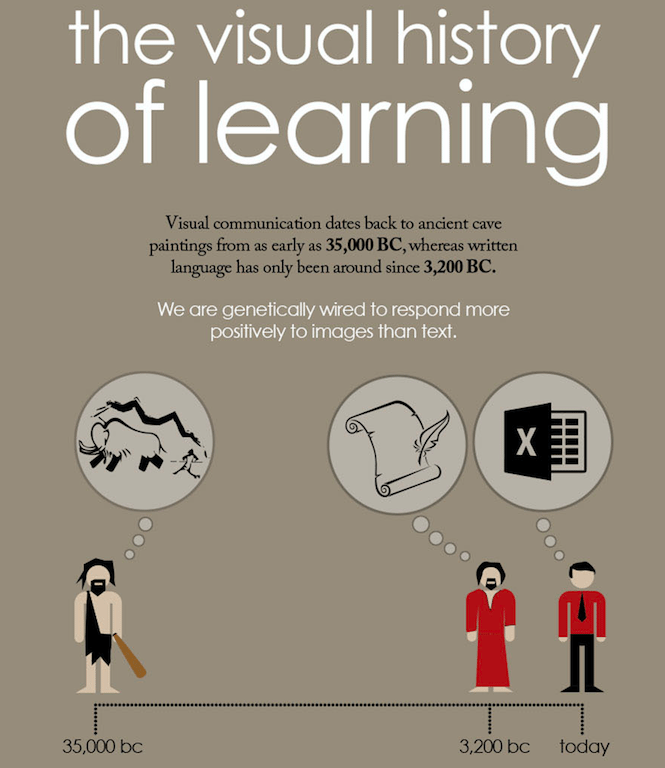
When it comes to successful tweets, a picture is worth 140 characters in quickly capturing the attention of your audience.
For that matter, you can get even more mileage with a picture that tells a complete story.
That’s where self-explanatory images enter. These are images that can stand on their own to completely explain a concept or idea, without the person needing to read any additional text.
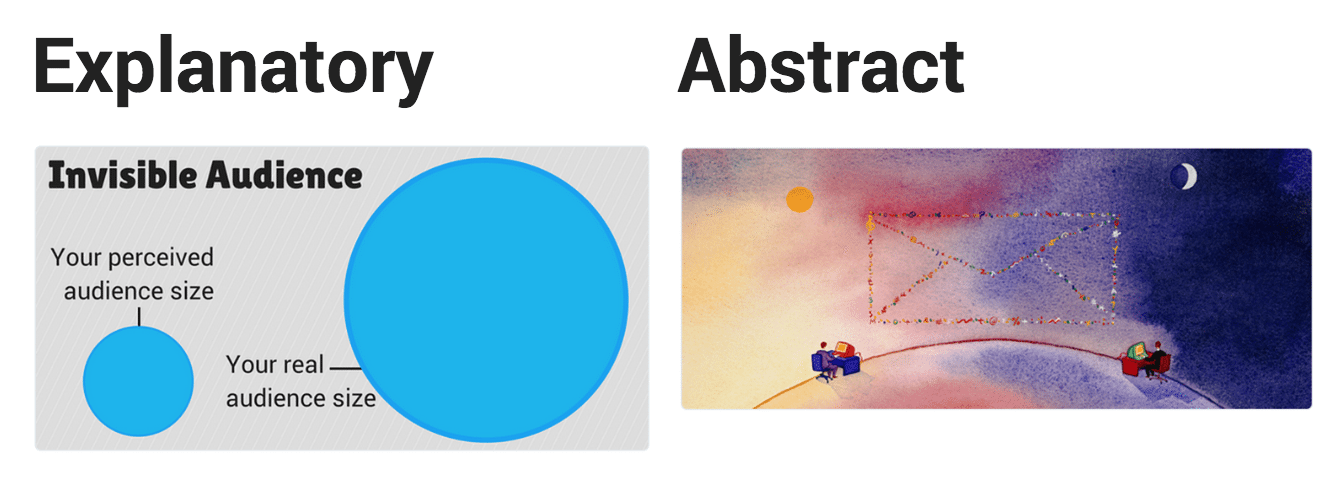
For self-explanatory images, users don’t have to click any links, read any captions, or visit another Twitter page to digest the information in the Tweet. This is one of the reasons that made it highly shareable. People respond well to the passing and sharing of information with no barriers.
Many times a quality stock photo will suffice (as those often tell a story as well), but other times images that include data, facts, quotes, etc. help to drive home the message in a much quicker and effective way.
Try asking these three questions:
- Would this image make sense with no caption at all?
- Does this image contain relevant or insightful content?
- Would I share this content myself on Twitter?
If the answer to at least 2 of the 3 questions is yes, you’re in a great place.
2. Choose a relatable and insightful topic that your audience will naturally share
No matter how good your images may be, if the topic isn’t something that people want to share then it’s going to be a tough sell for your audience.
But your audience wants to like it and they want to share it with their friends.
There’s only one catch … They have so much content to choose from.
This eye-opening study from Excelacom shows just how much online content there really is. To give you an idea, here’s how much content is produced on social media every single minute:
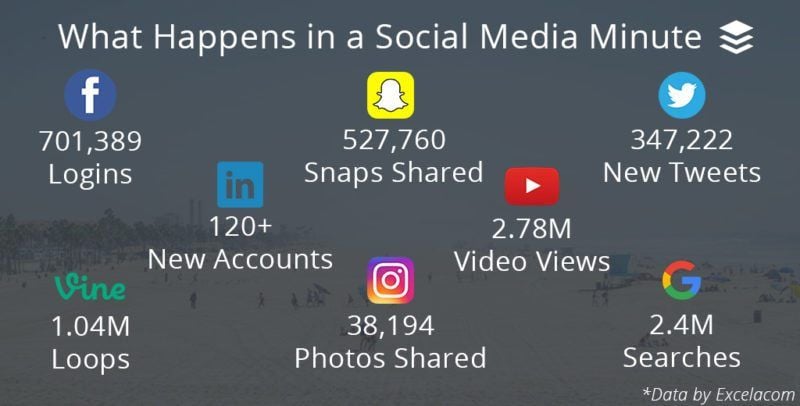
So how, in all of this content, do you produce successful tweets on a consistent basis?
You get inside your audience’s head. You make your content so compelling and so unique that they want to be the first to share it among their friends and family.
There are several key psychological reasons behind why people share great content, but let’s explore two of the most important reasons so that you can experiment in your next campaign.
1. People share to entertain friends and family
According to a 2016 study from Fractl, the number one reason people share content on social media is to entertain. Of the 2,000 people that were surveyed, an overwhelming 43% of people share content that they “think their friends will find entertaining.”
Sharing content that aims to entertain serves two key purposes.
- It helps people to build and nurture relationships with those that are close to us
- It helps people to connect with those they may not otherwise stay in touch with
Creating content with the ultimate goal of entertainment can be an extremely powerful lever in your social media strategy.
2. People share to express personal feelings or beliefs
We’ve all been here.
We see something that we like or that we personally believe in and feel compelled to share. Though most of us don’t end up sharing anything at all, an incredible study back in 1966 by the Harvard Business Review found that 64% of sharing is about the sharer themselves.
We share content that helps to define who we are.
Supporting a cause, getting involved, and defining ourselves are all behaviors in expressing personal feelings or beliefs and are important to consider when creating content for social media.
3. Piggyback on timely or trending news (that is already on people’s minds)
Publishing timely or trending news is something we’ve been experimenting with a lot here at Buffer in the last few months. We’ve experimented with writing about trending stories like F8, Snapchat 2.0, and Instagram Business Tools along with a handful of other timely topics.
Three out of 10 of our most successful tweets are tweets in which we leveraged trending news.
Being the “first to the scene” works extremely well in terms of traffic and shares when we seem to have found the perfect angle on the topic. If you’re able to find that angle it is much more likely to get shared by your audience on social media.
Usability with trending news and updates can be a key factor in sharing.
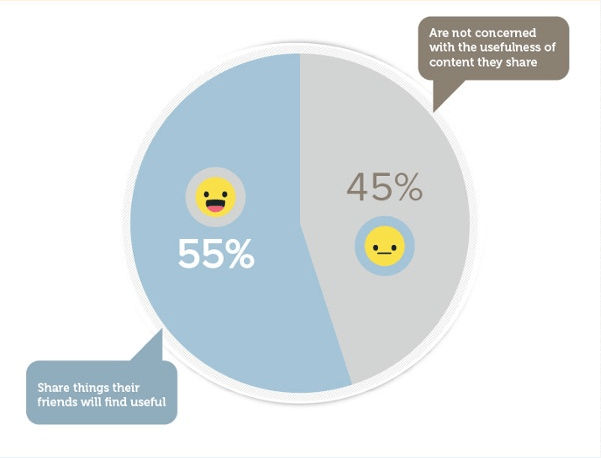
Remember that the goal is to create content that people believe will entertain their friends or content that fits within their belief system. That’s a bit tougher to do when writing about a timely or trending topic because several other publishers are talking about the same thing.
And so the key is to find a unique angle that no other brand or publisher is talking about.
Here are some examples of angles that we took on trending stories using compelling headlines to help us stand out from the crowd.
F8 Conference
- The Verge: “F8 conference 2016: the biggest news from Facebook’s developer event”
- Buffer: “F8 Update: 10 New Facebook Features Every Marketer Should Know”
Snapchat Geofilters
- MarketingLand: “Up close: How the new Snapchat On-Demand Geofilters work”
- Buffer: “Everything You Need to Know About Snapchat Geofilters (And How to Build Your Own)”
It’s important to point out that all of these headlines worked well in terms of shares and so there’s no “right or wrong” here. However, ours performed alongside top publishers because of the added value we provided.
4. Run social media giveaways because people love free things
Turns out that, when faced with several choices, we gravitate towards the item that is free, regardless of its economic value.
In Predictably Irrational: The Hidden Forces That Shape Our Decisions, Duke professor Dan Ariely writes:
Most transactions have an upside and a downside, but when something is FREE! we forget the downside. FREE! gives us such an emotional charge that we perceive what is being offered as immensely more valuable than it really is.
And so when looking at our 10 most successful tweets, it’s no surprise that No. 2 and No. 3 were giveaways on Twitter. Giveaways offer brands an inexpensive way to drive shares on social media while also giving back to a loyal community.
Before starting a Twitter giveaway, consider what you would like to achieve with your promotion. Is it more traffic to your website? More followers to your Twitter account? Or is it simply an opportunity to give back?
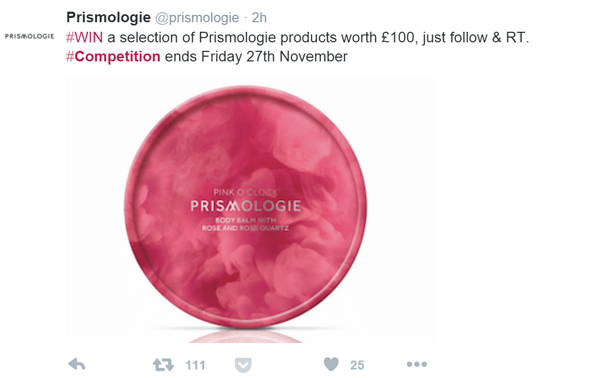
Social Media Examiner has an awesome 4-step checklist for running successful Twitter contests, which we’ve used several times to guide our strategy. Overall, remember these common elements before starting yours:
- Schedule contest teaser tweets in advance to build interest.
- Include an image or visual to attract attention and increase engagement.
- Choose a single, clear call to action for best results.
- Post clear terms and conditions.
- Announce the winners and thank everyone for taking the time to enter when the contest ends.
5. Add a “Wow” factor to stimulate the brain
There are only a few things that get people to share quicker than lighting up their brain with instant stimulation. When people see something that is particularly incredible or shocking, their brain immediately thinks “share.”
Just like you as marketers can create a “wow factor” with audiences through excellent customer service, you can create that same “wow factor” with information and content.
When’s the last time you were scrolling through your feed on Twitter and saw something that made you stop in your tracks?
That is the sort of content you can aim to create or curate in your most successful tweets.
One surefire way to deliver the “wow factor” to your audience is through statistics and data which is both visual and interesting. Take these two graphics for example that each garnered more than 300 shares on Twitter:
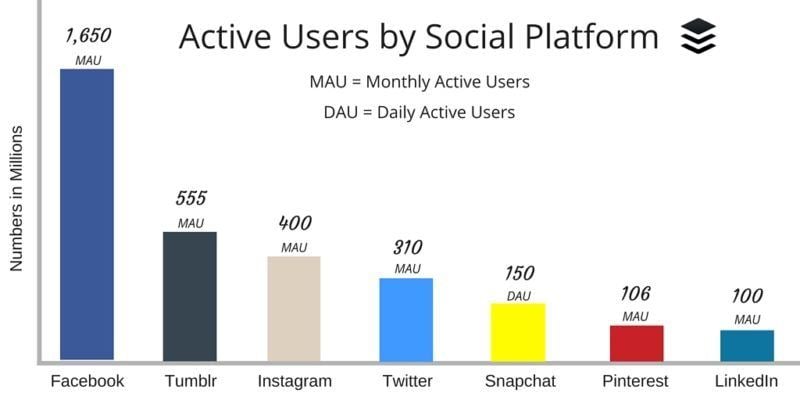
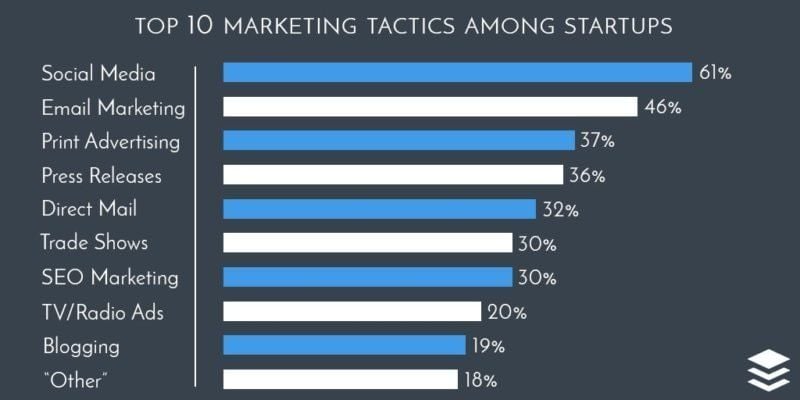
Each one took about 20-30 minutes to create but paid huge dividends in terms of social media ROI.
Always be on the lookout for areas in which you can uncover interesting or useful data and turn it into social media content.
6. Curate content
A whopping 6/10 of our most successful tweets are made up of curated content.
Which begs the question: why?
There are two key factors at play here which I think make a huge difference in the shareability of a brand’s content.
- It’s a huge challenge to create amazing content on a consistent basis. Curating content allows marketers to take the best content from around the web and use it to develop their brand as an industry thought leader while building relationships with the original publisher. Over time your audience will begin to go to you for quality information about industry news and insights.
- The psychological principle of Mere Exposure Theory.This principle states that, “the more we are exposed to something, the more we like it.” The more quality content that you are able to produce on social media the better. Curating quality content will not only increase your exposure to new audiences, but it will increase your frequency of success.
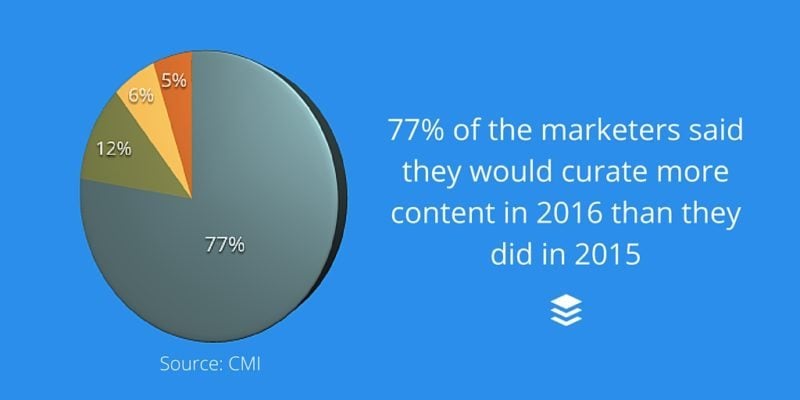
In a study conducted by Content Marketing Institute, 77% of the participants said they would curate more content in 2016 than they did in 2015 – signaling the fact that brands are seeing results from content curation.
Over to you!
What psychological elements make up your most successful Tweets?
Are you seeing success with giveaways? How about curated content?
I’d love to hear from you in the comments about your secret Twitter sauce and how you’ve found success in the past.
Try Buffer for free
190,000+ creators, small businesses, and marketers use Buffer to grow their audiences every month.


